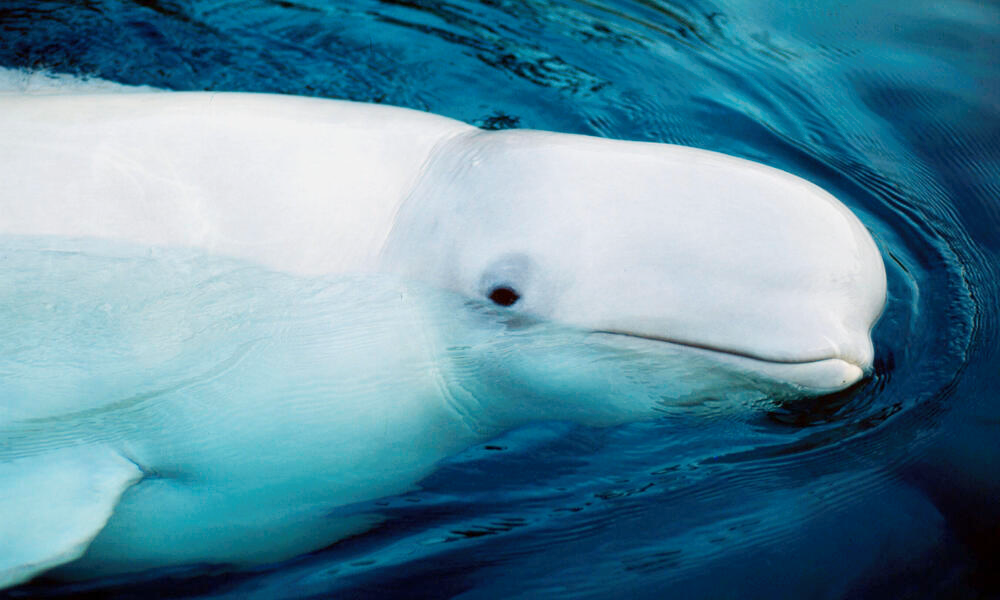Biology and Appearance
Beluga whales, scientifically known as Delphinapterus leucas, are members of the cetacean family, which includes dolphins and porpoises. They are easily recognizable by their distinctive white coloration, which is a result of their lack of pigment. Unlike most other cetaceans, belugas lack a dorsal fin, which allows them to navigate under ice-covered waters with ease.
These whales possess a robust, rounded body shape, and their foreheads bulge slightly, giving them a unique appearance. Belugas also have a flexible neck that allows them to turn their heads in all directions. Their flippers are paddle-shaped, aiding in maneuverability. However, their tail flukes are broad and powerful, facilitating swift propulsion through the water.
Behavior and Social Structure
Beluga whales are highly social animals, often found in groups known as pods. These pods can consist of a few individuals to several dozen, with larger gatherings occurring in areas where food is abundant. Within these pods, belugas display complex social behaviors, including communication through a variety of vocalizations.
One of the most striking features of beluga behavior is their vocal repertoire. These whales are popular as the “canaries of the sea” due to their diverse range of sounds. These vocalizations are used for communication, navigation, and possibly even hunting.
Belugas are also known for their playful nature, often engaging in behaviors such as breaching, spy-hopping (raising their heads above the water to observe their surroundings), and playing with objects such as seaweed or even pieces of ice. These playful antics not only serve as a form of social bonding but also contribute to their overall well-being.
Feeding Habits
Beluga whales are opportunistic feeders, consuming a wide variety of prey depending on their location and the season. Their diet primarily consists of fish, such as cod, herring, and salmon, as well as invertebrates like squid and shrimp. In some areas, belugas have been observed using cooperative hunting strategies, herding fish into shallow waters before launching coordinated attacks.
Their ability to echolocate, using sound waves to detect prey, is crucial for hunting in the often murky waters of the Arctic. Belugas emit high-frequency clicks and listen for the echoes bouncing off nearby objects, allowing them to locate and capture their prey with remarkable precision.

Reproduction and Life Cycle
Beluga whales reach sexual maturity between the ages of five and eight, with females typically maturing slightly earlier than males. Mating typically occurs in late spring or early summer, with females giving birth to a single calf after a gestation period of around 14 to 15 months.
Calves are born tail-first to prevent drowning and are immediately able to swim alongside their mothers. They are nursed for approximately one to two years, during which time they learn essential survival skills from their mothers and other members of the pod. Belugas have a relatively long lifespan, with individuals in the wild living up to 30 years or more, while those in captivity can live even longer.
Conservation Status and Threats
Despite their widespread distribution throughout the Arctic and subarctic regions, beluga whales face a variety of threats that jeopardize their survival. Habitat degradation, including pollution, industrial development, and climate change, poses significant challenges to beluga populations. Oil and gas exploration, shipping traffic, and underwater noise pollution can disrupt their communication, navigation, and feeding behaviors.
Overfishing and the depletion of prey species also impact beluga populations, reducing their access to vital food sources. Additionally, belugas are sometimes targeted by hunters for their meat, blubber, and other body parts, although regulations and conservation efforts have helped mitigate this threat in some areas.
Conservation organizations and governmental agencies are working to address these challenges through research, habitat protection, and outreach initiatives. Efforts to establish marine protected areas, regulate industrial activities, and mitigate climate change are essential for safeguarding the future of beluga whales and their ecosystems.
Conclusion
The beluga whale is a symbol of the Arctic, a creature whose beauty and resilience inspire awe and admiration. From its striking appearance to its complex social behaviors, the beluga captivates us with its charm and grace. Yet, as our planet faces unprecedented environmental challenges, it is imperative that we take action to protect these magnificent creatures and the fragile ecosystems they inhabit. By working together to address threats such as pollution, habitat loss, and climate change, we can ensure a brighter future for the beluga whale and all marine life.









